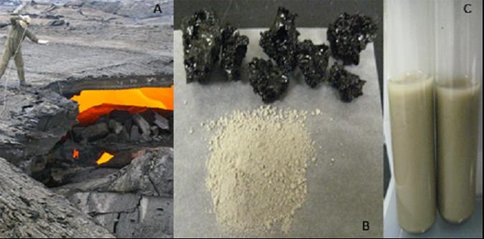2009 Annual Science Report
 University of Wisconsin
Reporting | JUL 2008 – AUG 2009
University of Wisconsin
Reporting | JUL 2008 – AUG 2009
Chemolithotrophic Microbial Oxidation of Insoluble Fe(II)-Bearing Minerals
Project Summary
Ferrous iron (Fe(II)) can serve as an energy source for a wide variety of chemolithotrophic microorganisms (organisms that gain energy from metabolism of inorganic compounds). Thought to be one of the oldest forms of microbial metabolism on Earth, Fe(II) oxidation may also have played a role in past (and possibly, present) life on Mars, whose crust is rich in Fe(II)-bearing silicate minerals (e.g. ultramafic basalt rocks). The initial goal of this project is to determine whether an established chemolithoautotrophic Fe(II)-oxidizing, nitrate-reducing culture can grow by oxidation of Fe(II) in basalt glass. Preliminary experiments suggest that the culture is able to oxidize a significant portion of the Fe(II) content of fresh basalt glass from Kilauea, a shield volcano in Hawaii that represents an analog for ancient volcanic activity on Mars.
Project Progress
We conducted preliminary experiments to determine whether the Fe(II)-oxidizing, nitrate-reducing culture can oxidize Fe(II) in basaltic glass. Previous and ongoing NAI-supported studies have demonstrated that this culture is capable of growing with insoluble Fe(II)-bearing phyllosilicate phases such as biotite, smectite, and illite. Our interest in the potential for microbial oxidation of Fe(II) in basalt glass stems from recent suggestions that near-surface hydrothermal venting may have occurred during past periods of active volcanic/tectonic activity on Mars. Such activities could have produced basalt glass phases that might have served as energy sources for chemolithotrophic microbial activity. Thus we sought to test whether the culture could oxidize the Fe(II) in basalt glass in a manner analogous to its ability to oxidize Fe(II) in insoluble Fe(II)-bearing phyllosilicate phases. The glass was obtained from an active lava flow from the Kilauea volcano in Hawaii.
USGS geologist sampling a lava tube at Kilauea, Hawaii (A). Rapid quenching of the lava in water produces chunks of basalt glass (B, upper), which were powderized and separated into clay sized materials (B, lower) for use as an energy source for the Fe(II)-oxidizing, nitrate-reducing culture©.
As a shield volcano, Kilauea has long stood as a Mars analog. The culture was initially grown on silt-to-sand sized particles of crushed glass suspended in anaerobic liquid media with nitrate as the electron acceptor. Initial results suggest chemolithotrophic Fe(II) oxidation took place: the dilute HCl-extractable Fe(II) content of the mineral suspensions declined over time in inoculated suspensions, whereas no significant Fe(II) loss took place in uninoculated controls. Analogous experiments are currently being conducted with clay sized particles to permit more accurate chemical measurements as well as determination of cell growth by direct counting. In addition, an HF extraction method is also being developed to determine the total amount of Fe(II) oxidized by the culture. Near-term future work will involve X-ray diffraction and electron microscopic analysis of the Fe phases produced during microbial Fe(II) oxidation. Parallel analyses will be conducted on glass samples oxidized abiotically by H2O2 to determine whether enzymatic activity produces compositionally or morphologically unique end-products.
Publications
-
Blothe, M., & Roden, E. E. (2009). Composition and Activity of an Autotrophic Fe(II)-Oxidizing, Nitrate-Reducing Enrichment Culture. Applied and Environmental Microbiology, 75(21), 6937–6940. doi:10.1128/aem.01742-09
-
PROJECT INVESTIGATORS:
-
PROJECT MEMBERS:
Clark Johnson
Co-Investigator
Huifang Xu
Co-Investigator
Andrew Honma
Graduate Student
-
RELATED OBJECTIVES:
Objective 4.1
Earth's early biosphere.
Objective 6.1
Effects of environmental changes on microbial ecosystems
Objective 7.1
Biosignatures to be sought in Solar System materials

